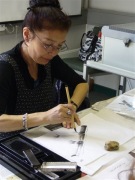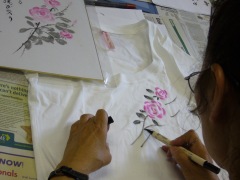

English Through Japanese Art and Literature: HAIGA
Noriko Yoshida, Japan
Noriko Yoshida has run her business called ‘Juku’ in Tokyo for more than 20 years. She teaches English and HAIGA, English for children and adults, HAIGA for children and adults too, especially at French School in Tokyo as an activity instructor sponsored by French parents Organization in Tokyo.
E-mail: haiga-n@beach.ocn.ne.jp
Menu
Introduction
The procedure of HAIGA seminar in Canterbury
Conclusion
Three Great Poets
As the most Japanese poets (haijin) travel and enlighten people on HAIKU, I do so too in the summer. At Pilgrims Teacher Training I give my seminars called English through Japanese Art HAIGA. It is 18th century Japanese art and literature completed by Yosa Buson, one of the greatest poets in Japan. It consists of a picture in ink and a Haiku. Haiku is the shortest poem composed with only 5-7-5 syllables. Recently composing English Haiku has been becoming more popular year by year. Compared with Japanese Haiku, English Haiku is more liberal to compose. For example, we can create a 3-5-3 syllable Haiku from a 5-7-5 one. Using kigo (a seasonal word) is not a restriction. Contrary to that, Japanese Haiku has many traditional rules.
When we compose Haiga, there are also some rules. However, the most important thing is to combine the same seasonal picture and poem, but different ones, e.g. a picture of a summer bell and a poem about summer wind. In Haiga, the poem and the picture are just like the air and the water, or a husband and a wife. The ideal Haiga is a Haiku which develops the scenery of the picture.
It’s indeed a sensory perceptive artwork !
First of all I give 8 sessions over two weeks. In the first session, first I give a lecture on the history of Japanese art and literature using OHP. It’s a chronology of Japanese Literature and Art from 10th century to 19th century, focusing on the artists and writers of each period and I compare them with the foreign ones. Of course, I ask my students about them. Then I show the highlight picture, e.g. a 12th century’s picture called Chojugiga, which is said to be the origin of Manga and quite a different picture of the landscape, called Sansuiga. Sansuiga is actually the origin of pictures in ink. Then finally I teach when, by whom and how Haiku and Haiga are composed. I use OHP sheets and handout documents to my students.
Using, “Three great poets” handout (see below), I introduce, Matsuo Basho, Yosa Buson and Kobayashi Ittsusa and I read Japanese poems, and my students read English ones. Sometimes my students read Japanese ones and I read English ones.
For the rest of the lesson, about 45 minutes, I give a demonstration of HAIGA. It may be said this is the most exciting lesson. First I explain the materials and we do a 20 second meditation. All my students like it ! Then I give a demonstration of four basic flowers – the bamboo, the plum, the orchard and the chrysanthemum. Then I teach each student their name in Japanese. Most students love it. I also teach one kanji called eternity. It’s the basic course. If a student is very ambitious, I teach more kanji or Japanese HAIKU.
On the second day, I teach how to compose English Haiku and also teach how to appreciate Haiga. Of course, this is The Teacher Training, so I have to teach some very academic but also artistic aspects. For example, I introducr the students to ”Japanese shooting raft picture” with Basho’s Haiku. So I ask each student: “Please look at only this picture and use submodalities, say what you can see, hear, smell and feel. Then using Haiku, what can you see, hear, smell and feel. It’s a good exercise to improve one’s observation for the nature and the inner and outer worlds. On the third day besides composing Haiga, I check how much they remember from my lecture.
On the fourth day I give a quiz. The second week has continuation lesson plus something different. We draw HAIGA on the white T shirt ! This summer, 20 students came with their white T- shirts ! They were very excited about it because they could make nice presents for their families, friends and so on.
I finally give everyone a Japanese certificate and an English certificate if my students’ attendance rate is over 60 %, if they compose a few English Haiku and pass aural tests (100% students pass). So far, many students’ English Haiku were printed on the Japanese English Newspaper “Herald Asahi Tribune”.
Through my course people improve their observation for the nature, inner and outer world. It’s a part of an NLP course, I think. Also people develop a great interest in the Asian culture because the can acquire a basic knowledge of HAIGA. and compare it with their culture and literature. Finally, my course is “2 birds killed with one stone” because they study, understand and make nice T-shirt presents for their families and friends.
In Edo Period 1603A.D.~1868A.D
Basho Matsuo (1644~1694)
| Furuike ya |
An old quiet pond |
| Kawazu tobikomu |
a frog is jumping into |
| Mizu no oto |
the sound of water |
| Shizukasaya |
Serenity |
| Iwa ni shimiiru |
sound of cicada |
| Semi no koe |
soaks in rocks |
Buson Yosa (1716~1783)
| Haru no umi |
Spring ocean |
| Hinemosu notari |
rises and falls calmly |
| Notati kana |
all day long |
| Sumizumi ni |
In every corner |
| Nokoru samusa ya |
feeling chilly in the room |
| Ume no hana |
the plum blossoms |
Issa Kobayashi (1763~1817)
| Suzukaze ya |
The cool breeze |
| Chikara ittupai |
with all his might |
| Kirigirisu |
grasshopper |
| Suzume no ko |
A baby sparrow |
| Soko noke soko noke |
go away, go away |
| Ouma ga touru |
a horse is coming |

Please check the Creative Methodology for the Classroom course at Pilgrims website.
Please check the Literature course at Pilgrims website.


|